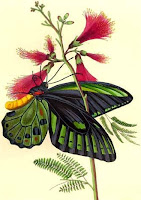The Phoenix and the Butterfly
Q: Is the phoenix mentioned in the Bible?
 A: The phoenix is not among the creatures named in the Bible. For those readers unfamiliar with it, this legendary bird symbolizes immortality, resurrection and life after death. In ancient Greek mythology, it was associated with the sun god. According to the Greeks, it lived in Arabia, near a cool well. Each morning at dawn, the sun god would stop his chariot to listen to the bird sing a beautiful song while it bathed in the well.
A: The phoenix is not among the creatures named in the Bible. For those readers unfamiliar with it, this legendary bird symbolizes immortality, resurrection and life after death. In ancient Greek mythology, it was associated with the sun god. According to the Greeks, it lived in Arabia, near a cool well. Each morning at dawn, the sun god would stop his chariot to listen to the bird sing a beautiful song while it bathed in the well.Only one phoenix existed at a time. When the bird felt its death was near, about every 500 years, it built a nest of aromatic wood and set it on fire. The bird then was consumed by the flames. A new phoenix sprang to life from the pyre. It embalmed the ashes of its predecessor in an egg of myrrh and flew with it to Heliopolis, “city of the sun,” where the egg was deposited on the altar of the sun god.
While only a myth, we can see how the story of the phoenix entered into Christian art and literature. The legend would have been familiar to many throughout the Mediterranean world. The bird's regenerated life was used by many in the early Christian Church to illustrate the resurrection of Jesus Christ and the future resurrection of all flesh.
 The phoenix became a symbol of new life following death: Christ died in the “fiery trial” of the cross. His death became an “aromatic” or “fragrant” sacrifice that pleased God the Father and sits always before Him (Ephesians 5:2). Meanwhile, on the third day, Christ rose again, even more glorious than before. In baptism, each Christian became a “phoenix,” participating in both the death and the resurrection of Jesus. This would be played out again as each died a physical death and rested in the tomb until the Last Day.
The phoenix became a symbol of new life following death: Christ died in the “fiery trial” of the cross. His death became an “aromatic” or “fragrant” sacrifice that pleased God the Father and sits always before Him (Ephesians 5:2). Meanwhile, on the third day, Christ rose again, even more glorious than before. In baptism, each Christian became a “phoenix,” participating in both the death and the resurrection of Jesus. This would be played out again as each died a physical death and rested in the tomb until the Last Day.Of course there are differences, so few pushed the idea too far. For one thing, Jesus died once and will never again taste death. For another, while He is “the only-begotten Son of God,” just as there was only one phoenix at a time, Christ makes all believers into one like Himself. Thus, in the Resurrection, all who believe will bear His image: Each saint will be an ever-living “phoenix.”
 The phoenix is not the only creature symbolically used by the Church. The butterfly similarly provided an illustration of both Christ’s life, death, and resurrection and that of the saints. The caterpillar stage for Christ was His time of public ministry, where, “He had no form or majesty that we should look at him, and no beauty that we should desire him. (Isaiah 53:2)” The chrysalis or cocoon stage symbolized His time in the grave, where He was as lifeless as the caterpillar seemed to become.
The phoenix is not the only creature symbolically used by the Church. The butterfly similarly provided an illustration of both Christ’s life, death, and resurrection and that of the saints. The caterpillar stage for Christ was His time of public ministry, where, “He had no form or majesty that we should look at him, and no beauty that we should desire him. (Isaiah 53:2)” The chrysalis or cocoon stage symbolized His time in the grave, where He was as lifeless as the caterpillar seemed to become.Finally, He burst out of the tomb in glorious new form, where even His faithful disciples could not recognize Him unless He revealed Himself (see Luke 24:13-48 and John 20:11-29). For the Christian, the contrast was that we not only appeared to be homely, but that in sin we were hideous in God’s eyes. Again, spiritual and temporal death contrast with new life on earth and eternal life with Christ in heaven through participation in Christ’s death and resurrection in Holy Baptism (see Romans 6:3-11).
Next time, we can look at other examples and illustrations from Scripture and from Christian art.
Scripture quoted from The Holy Bible, English Standard Version™, © 2001 by Crossway Bibles.
Send email to Ask the Pastor.
Walter Snyder is the pastor of Holy Cross Lutheran Church, Emma, Missouri and coauthor of the book What Do Lutherans Believe.
Technorati Tags: heaven | phoenix | ashes | Jesus | Christ | Jesus Christ | resurrection | eternal life | cocoon | caterpillar | worm | chrysalis | butterfly | Christian symbolism | Christian art | Bible | Scripture | Christianity

0 Comments:
Post a Comment
<< Home